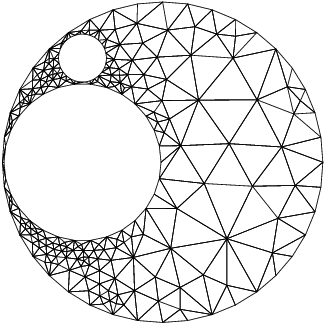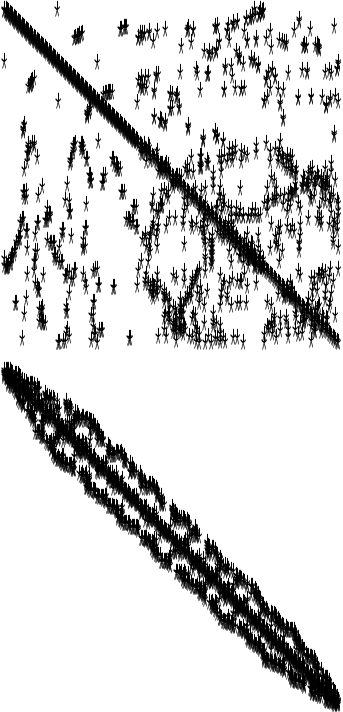D06CCF renumbers the vertices of a given mesh using a Gibbs method, in order the reduce the bandwidth of Finite Element matrices associated with that mesh.
| SUBROUTINE D06CCF ( |
NV, NELT, NEDGE, NNZMAX, NNZ, COOR, EDGE, CONN, IROW, ICOL, ITRACE, IWORK, LIWORK, RWORK, LRWORK, IFAIL) |
| INTEGER |
NV, NELT, NEDGE, NNZMAX, NNZ, EDGE(3,NEDGE), CONN(3,NELT), IROW(NNZMAX), ICOL(NNZMAX), ITRACE, IWORK(LIWORK), LIWORK, LRWORK, IFAIL |
| REAL (KIND=nag_wp) |
COOR(2,NV), RWORK(LRWORK) |
|
D06CCF uses a Gibbs method to renumber the vertices of a given mesh in order to reduce the bandwidth of the associated finite element matrix
. This matrix has elements
such that:
This routine reduces the bandwidth
, which is the smallest integer such that
whenever
(see
Gibbs et al. (1976) for details about that method). D06CCF also returns the sparsity structure of the matrix associated with the renumbered mesh.
This routine is derived from material in the MODULEF package from INRIA (Institut National de Recherche en Informatique et Automatique).
Gibbs N E, Poole W G Jr and Stockmeyer P K (1976) An algorithm for reducing the bandwidth and profile of a sparse matrix SIAM J. Numer. Anal. 13 236–250
- 1: NV – INTEGERInput
On entry: the total number of vertices in the input mesh.
Constraint:
.
- 2: NELT – INTEGERInput
On entry: the number of triangles in the input mesh.
Constraint:
.
- 3: NEDGE – INTEGERInput
On entry: the number of boundary edges in the input mesh.
Constraint:
.
- 4: NNZMAX – INTEGERInput
On entry: the maximum number of nonzero entries in the matrix based on the input mesh. It is the dimension of the arrays
IROW and
ICOL as declared in the subroutine from which D06CCF is called.
Constraint:
.
- 5: NNZ – INTEGEROutput
On exit: the number of nonzero entries in the matrix based on the input mesh.
- 6: COOR(,NV) – REAL (KIND=nag_wp) arrayInput/Output
On entry: contains the coordinate of the th input mesh vertex, for ; while contains the corresponding coordinate.
On exit: will contain the coordinate of the th renumbered mesh vertex, for ; while will contain the corresponding coordinate.
- 7: EDGE(,NEDGE) – INTEGER arrayInput/Output
On entry: the specification of the boundary or interface edges. and contain the vertex numbers of the two end points of the th boundary edge. is a user-supplied tag for the th boundary or interface edge: for an interior edge and has a nonzero tag otherwise.
Constraint:
and , for and .
On exit: the renumbered specification of the boundary or interface edges.
- 8: CONN(,NELT) – INTEGER arrayInput/Output
On entry: the connectivity of the mesh between triangles and vertices. For each triangle
, gives the indices of its three vertices (in anticlockwise order), for and .
Constraint:
and and and , for and .
On exit: the renumbered connectivity of the mesh between triangles and vertices.
- 9: IROW(NNZMAX) – INTEGER arrayOutput
- 10: ICOL(NNZMAX) – INTEGER arrayOutput
On exit: the first
NNZ elements contain the row and column indices of the nonzero elements supplied in the finite element matrix
.
- 11: ITRACE – INTEGERInput
On entry: the level of trace information required from D06CCF.
- No output is generated.
- Information about the effect of the renumbering on the finite element matrix are output. This information includes the half bandwidth and the sparsity structure of this matrix before and after renumbering.
- The output is similar to that produced when but the sparsities (for each row of the matrix, indices of nonzero entries) of the matrix before and after renumbering are also output.
- 12: IWORK(LIWORK) – INTEGER arrayWorkspace
- 13: LIWORK – INTEGERInput
On entry: the dimension of the array
IWORK as declared in the (sub)program from which D06CCF is called.
Constraint:
.
- 14: RWORK(LRWORK) – REAL (KIND=nag_wp) arrayWorkspace
- 15: LRWORK – INTEGERInput
On entry: the dimension of the array
RWORK as declared in the (sub)program from which D06CCF is called.
Constraint:
.
- 16: IFAIL – INTEGERInput/Output
-
On entry:
IFAIL must be set to
,
. If you are unfamiliar with this parameter you should refer to
Section 3.3 in the Essential Introduction for details.
For environments where it might be inappropriate to halt program execution when an error is detected, the value
is recommended. If the output of error messages is undesirable, then the value
is recommended. Otherwise, if you are not familiar with this parameter, the recommended value is
.
When the value is used it is essential to test the value of IFAIL on exit.
On exit:
unless the routine detects an error or a warning has been flagged (see
Section 6).
If on entry
or
, explanatory error messages are output on the current error message unit (as defined by
X04AAF).
Not applicable.
None.
In this example, a geometry with two holes (two interior circles inside an exterior one) is considered. The geometry has been meshed using the simple incremental method (
D06AAF) and it has
vertices and
triangles (see
Figure 1). The routine
D06BAF is used to renumber the vertices, and one can see the benefit in terms of the sparsity of the finite element matrix based on the renumbered mesh (see
Figure 2).
Figure 1: Mesh of the geometry
Figure 2: Sparsity of the matrix before (top) and after (bottom) the renumbering


